Table of contents
- Technology development in valve actuation State of the art
- 2 Valve actuation requirements
- Mechanics are simpler today
- Diaphragm valve, vertical valve, bumper
- Standing valves, rocker arms, bumpers
- Rocker arm, bumper
- ohc, rocker arms
- dohc, bucket tappets
- dohc, rocker arm
- A clever combination: mixed forms
- interview
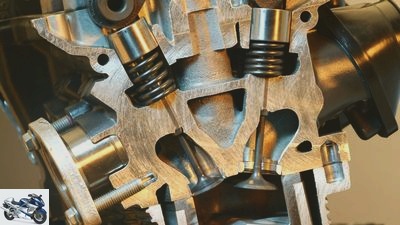
factstudio.de
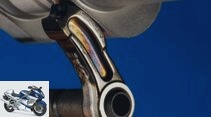
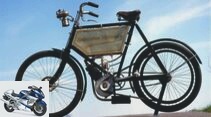
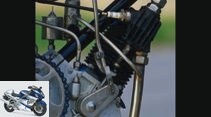
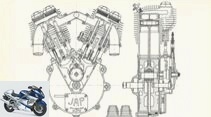
23 pictures
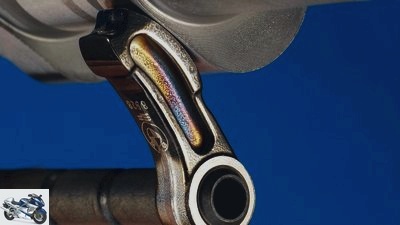
Katrin Sdun
1/23
Before valve actuation via rocker arms prevailed, numerous other designs determined the state of the art.

Ralf Schneider
2/23
When starting the engine via a bicycle drive with freewheel…
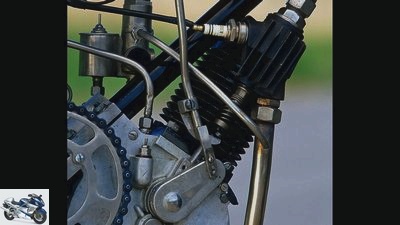
r-photography.info
3/23
…the valve lifter between the bumper and the exhaust valve helped.
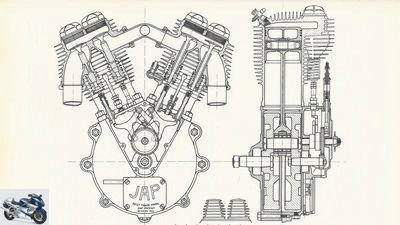
MOTORCYCLE
4/23
An example of the complexity of early valve actuation.
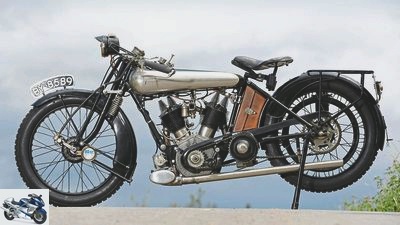
r-photography.info
5/23
The “cooling towers” protrude from the cylinder heads to under the tank.
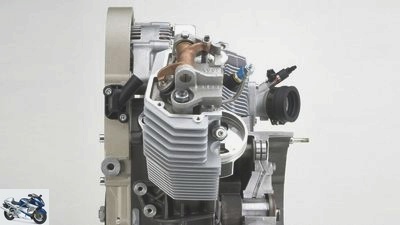
Eva Breutel
6/23
Moto Guzzi V7: bumper and rocker arm with adjusting screw for valve clearance.
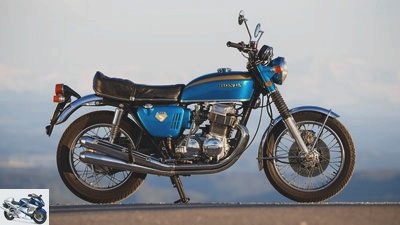
jkuenstle.de
7/23
The first large-scale four-cylinder made its debut in the Honda CB 750 in 1969.
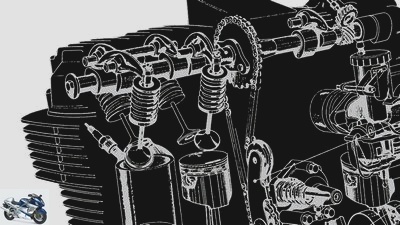
MOTORCYCLE
8/23
Four cylinders with 500, 550, 350, 400 and 650 cm³ followed.

Royal Enfield
9/23
The current example of valve actuation via rocker arms…
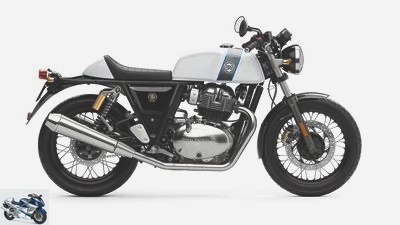
Royal Enfield
10/23
…The new 650 twin from Royal Enfield move four valves per combustion chamber via forked roller rocker arms.
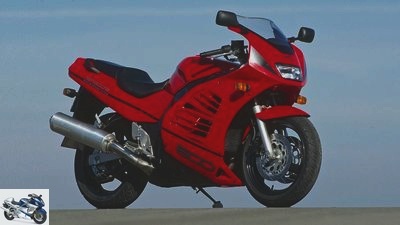
Hartmann
11/23
The RF 600…
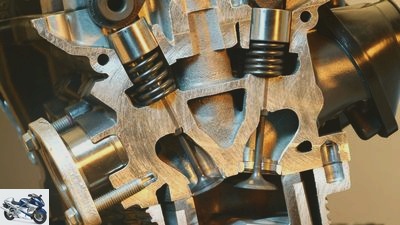
factstudio.de
12/23
…stands for the transition from the air / oil-cooled to today’s Suzuki engines.
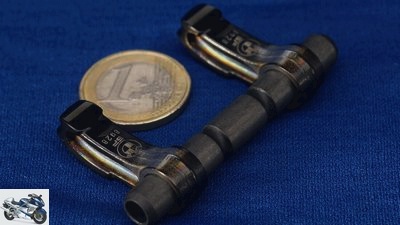
Katrin Sdun
13/23
The coin is used to compare the size…
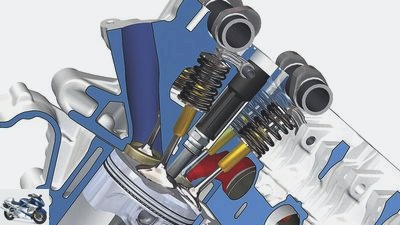
BMW
14/23
…and says nothing about the cost of the S 1000 RR rocker arm.
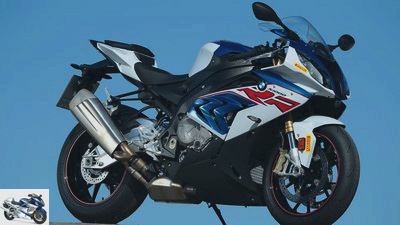
r-photography.info
15/23
Good for real 200 hp from one liter displacement: the four-cylinder of the S 1000 RR…

r-photography.info
16/23
…and Yamaha YZF-R1.

archive
17/23
Honda’s unicam principle is not suitable for high speeds.

factstudio.de
18/23
But they weren’t even asked for with the VFR engine (Honda VFR 1200 F).
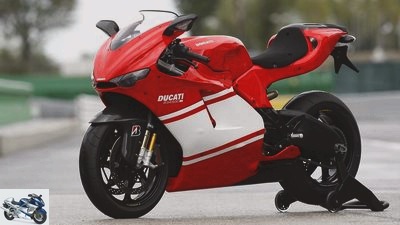
jkuenstle.de
19/23
Ducati Desmosedici RR: Like the Twins…
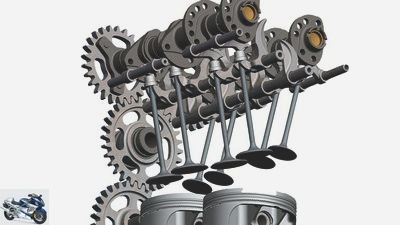
archive
20/23
…the V4 operates the valves desmodromically via rocker arms and rocker arms.

r-photography.info
21/23
Harley-Davidson 16 F: Your engine was called the “Pocket valve engine”…
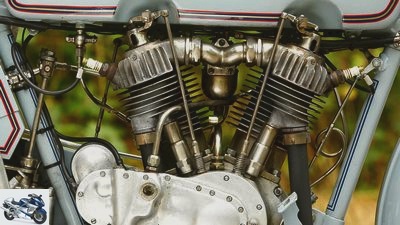
r-photography.info
22/23
…because the rocker arms of the inlet valves required recesses in the tank.

BMW
23/23
Another hybrid form: until 2007, BMW used a high-lying camshaft, tappets, short bumpers and fork rocker arms for the four-valve boxers.
counselor
workshop
Technology development in valve actuation
Technology development in valve actuation
State of the art
Valve actuation via rocker arms is now considered to be the most suitable for light, high-revving motorcycle engines. But before it caught on in mass production, numerous other designs determined the state of the art. An overview.
Ralf Schneider
08/28/2018
When is a valve opened, how fast and how far? How long will it stay open, how quickly will it be closed again? These values are fundamental to the performance and efficiency of four-stroke engines and, with a few exceptions, are determined by the shape of the cams on the camshaft. However, no cam presses directly on a valve. Because its shaft has to be made as thin as possible for reasons of weight, the cam would bend it irreparably the first time it was started. Therefore, there is always at least one actuating element between the cam and the upper end of the valve stem. Small, often inconspicuous, these actuating elements are extremely important for the function of a motor.
Buy complete article
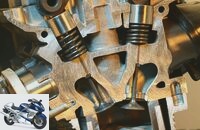
Technology development in valve actuation
State of the art
8 pages) as PDF
€ 2.00
Buy now
2 Valve actuation requirements
Despite all efforts to achieve low weight, a valve cannot be a mass-free component, and in the overwhelming majority of all four-stroke engines it has to be pushed open against the force of the valve spring (s). From these simple facts there are two main requirements for efficient valve actuation:
1.) The moving masses must be as small as possible in order to minimize moments of inertia and thus allow the valves to open and close quickly. The faster and further a valve can be moved, the greater the gas throughput and thus the greater the performance.
2.) the contour of the cams must be precisely transferred to the valves, i.e. the valve actuation must be as stiff as possible. If part of the applied forces dissipate in the elasticity of the system every time the valve is actuated, for example by bending a bumper sideways, the timing is not precisely adhered to and the engine needs more power to keep itself running instead of propelling a vehicle.
In principle, higher rigidity of the valve actuation can be achieved with more material, but this in turn makes the parts heavier. As you can see, only extremely clever designs can meet both requirements in a satisfactory manner.
Mechanics are simpler today
The development history of valve actuation is part of a much broader development of four-stroke technology towards ever higher speeds, more power, more economical consumption, lower pollutant emissions, lower weight, more compact design, higher mileage at still reasonable production costs. The more these contradicting development goals had to be reconciled, the more the elements of the valve actuation corresponded to the basic requirements formulated above.
What is particularly fascinating is the fact that the constructions have not necessarily become more complicated in the course of development. Ohv valve actuation with a tappet, bumper and rocker arm requires more mechanical effort than valve actuation via bucket tappets. Even rocker arms of the latest design, such as the BMW S 1000 RR and Yamaha YZF-R1, manage with relatively simple mechanics. Here, however, there is an enormous amount of effort involved in processing and coating the small oscillating levers. On closer inspection, they turn out to be fascinating parts.
Diaphragm valve, vertical valve, bumper
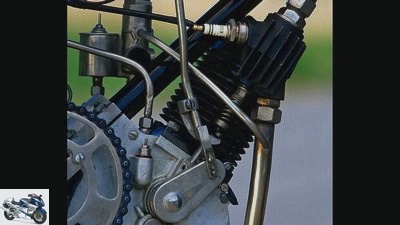
r-photography.info
The earliest engines only had one controlled valve.
The NSU from 1902 had a Zedel engine with a diaphragm or sniffer valve in the intake tract. As long as the downward sliding piston produced enough vacuum to “suck up” the metal membrane, the mixture could flow into the combustion chamber. The standing exhaust valve, on the other hand, had to be controlled by a cam; it was operated via a short bumper. The pursuit of more power brought with it higher speeds, temperatures and combustion pressures; they pushed the sniffer valve in the inlet to its limits and beyond. The designers recognized the need to use cam-controlled valves in the intake as well. This development took place over the course of a few years.
Standing valves, rocker arms, bumpers
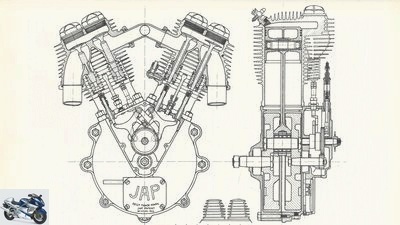
MOTORCYCLE
Vertical valves, rocker arms, bumpers: under the control cover are multi-armed rocker arms.
In the side-controlled JAP-V2 from the early 1920s, a short camshaft with only one inlet and outlet cam controlled all four valves. This was made possible by complex multi-armed rocker arms in the control housing on the left side of the engine. The rocker arms transferred the cam contour to short bumpers, which in turn pressed onto the shafts of the standing valves. The valves were installed through holes on the top of the cylinder head. After assembly, these were closed with screwed-in plugs. For better cooling, there were high stoppers with cooling fins, real “cooling towers” as an option.
Rocker arm, bumper

Eva Breutel
Rocker arm, bumper: the longest and still used valve actuation.
The BMW two-valve engines, the venerable English in-line two-cylinders from BSA to Norton to Triumph, the Big Twins and Sportster engines from Harley, the V7 and V9 engines from Moto Guzzi – all relied on valve actuation via bumpers and rocker arms. Usually there is also a tappet between the cam and the bumper. The advantage of this principle lies in the low overall height of the cylinder heads and the short transmission paths of the camshaft drive. The complex mechanics, the comparatively heavy moving masses and the deflection of the often long bumpers have a disadvantage. Speeds of over 8000 rpm are therefore hardly possible in the long term with an ohv valve train in large-scale production. The principle is now a case for rather leisurely engines.
ohc, rocker arms
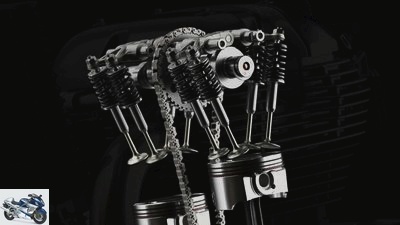
Royal Enfield
The current example of valve actuation via rocker arms: the new 650 twin from Royal Enfield.
The valve actuation via an overhead camshaft and rocker arm avoids the elasticity of ohv constructions, but not the lateral loading of the valves during the opening phase. Nevertheless, the principle in the Honda four-cylinder engines was suitable for speeds of up to around 10,000 rpm – in the 350 and 400 engines even more – and exemplary mileage. Despite the complicated machining of the camshaft with alternating inlet and outlet cams and the complex rocker arm mechanism, the ohc engines were apparently cheaper to produce than engines with two overhead camshafts, so that Honda stuck to them for a good ten years.
dohc, bucket tappets
After the exotic MV four-cylinder engines of the late 1960s, Kawasaki was the first manufacturer in 1972 to mass-produce an engine with two overhead camshafts. Ground plates, first on, then to save weight under the bucket tappets, were used to adjust the valve clearance. The 1993 Suzuki RF 600 engine shown above actually meant a step backwards in terms of valve actuation, as the air / oil-cooled engine series, which debuted in the GSX-R 750 in 1985, already had fork finger followers. The change to the bucket tappet motor was made for cost reasons, as was Honda with the PC 25 CBR 600 F or Kawasaki with the ZX-7R, to name just two other examples. It was only when the 1000-cc super sports car started targeting the 200-hp limit that rocker arms came back into consideration.
dohc, rocker arm
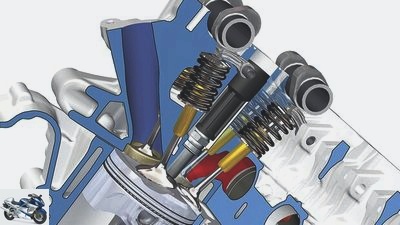
BMW
World Cup-compatible racing technology in large-scale production.
It is the lower moving masses that have the greatest advantage of rocker arms over bucket tappets and thus the possibility of realizing higher valve accelerations. To be more precise, you have to write “sliding finger followers”, because a roller rocker arm would destroy the weight advantage again. Furthermore, rocker arms support the side forces that arise when the cam starts running more efficiently than bucket tappets. Allegedly the levers of the BMW S 1000 RR four-cylinder come from the BMW Formula 1 engines that turned over 18,000 rpm. For tamer versions of the S 1000 four-cylinder, which do not turn 14,000 rpm, the side surfaces were not milled out in order to save costs. When the redesign of the YZF-R1 was due for 2015, Yamaha also brought the rocker arm technology of the MotoGP engines into series production. It will be interesting to see when other manufacturers will follow suit. The advantages in terms of performance characteristics are obvious.
A clever combination: mixed forms

archive
It does not always have to be the pure application of a principle.
Desmodromic valve control, as is typical for Ducati engines, would not be possible without the use of rocker arms to close the valves. In order to move the smallest possible mass when opening, the designers combine rocker arms and rocker arms. The pursuit of light and compact cylinder heads was in the foreground with the so-called Unicam engines, which were used in motocrossers, but also in the VFR 1200 models. The intake valves are operated by bucket tappets, the smaller exhaust valves by the same camshaft via a roller rocker arm. The first V2 from Harley-Davidson has a hanging inlet and a standing outlet valve per cylinder. The valves are actuated correspondingly differently.
interview
The main advantage of valve actuation using slide rocker arms compared to bucket tappets is the lower moving mass. What other advantages do sliding rocker arms have?
High-revving naturally aspirated engines with a correspondingly high liter output have always been of great importance to BMW. This concept offers decisive advantages in terms of responsiveness and weight. The valve train plays an essential role here, i.e. in realizing optimal gas exchange. In order to represent the required high liter output with a good torque curve at the same time, full cam profiles are required. The slide rocker arm is the optimal design for this. The greatest advantage of the slide rocker arms is the favorable ratio of high flexural rigidity and low moving mass. Due to the high loads, a wear-resistant surface such as a DLC (diamond-like carbon) coating is required.
Can the advantages of rocker arms with regard to possible valve accelerations be roughly quantified? How tall are you?
In today’s motorcycles such as the S 1000 RR with a maximum speed of 14,200 rpm and a liter output of 200 hp, valve accelerations of up to 40,000 m / s² occur. In order to cope with the resulting inertia forces, in addition to the rocker arm, the use of ultra-light titanium valves is necessary. Other valve trains are factors lower in terms of valve acceleration, depending on the design.
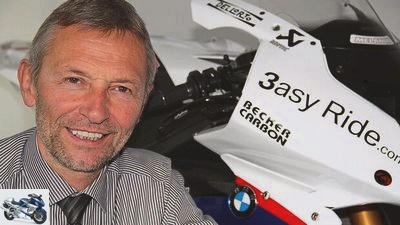
BMW motorcycle
Norbert Klauer, Head of Engine Development at BMW Motorrad, on the advantages and disadvantages of various valve actuations.
Based on a four-cylinder motorcycle engine with a displacement of 1000 cm³ and a bore of 76 to 80 millimeters: At what speed and liter output do the BMW engine technicians see the limit of valve actuation by bucket tappets?
In order to meet the demands of BMW with regard to a full torque curve with a high liter output at the same time, we see the rocker arm as the more advantageous concept above around 10,000 rpm. As other manufacturers show, speeds of 13,500 rpm and liter outputs of around 200 hp are also possible with bucket tappets, but only with smaller valves and / or less bulky cam lobes. This leads to a clearly visible difference in the performance curves.
A BMW technician once told an editor colleague that the slide rocker arms of the K 1200/1300 and the first boxer series with a dohc valve train were one of the most expensive engine components, both in terms of development and production costs. What special difficulties arise in the development and manufacture of slide drag levers??
When the K 1200 S was developed almost 20 years ago, the use of sliding drag levers was only known from motorsport applications. The challenge was to master the very high surface pressures that occur between the cam and the sliding surface of the rocker arm. The solution for this is to coat the sliding surface with a surface that is as hard and wear-resistant as a diamond. Also known as DLC (diamond-like carbon). At that time, this process was only available for small series and had to be further developed for large series. Therefore, both the development and the industrialization were correspondingly complex and expensive. In the meantime, however, it corresponds to the state of the art.
At low speeds, roller rocker arms generate a lower drag torque than slide rocker arms or bucket tappets. What other advantages does this type of valve actuation have and what are its disadvantages?
The main advantage of the roller finger follower is the lower friction. The disadvantage lies in the lower rigidity, in the weight and in the space required. This results in lower possible valve accelerations and maximum speeds.
What are the advantages and disadvantages of sleeve and inverted tooth chains as camshaft drives??
The inverted tooth chain, which is also referred to as “silent chain”, has its main advantage in terms of acoustics and, with the same dimensions, in a higher transferable chain force. The advantage of the sleeve chain is the low tendency to skip. As a result, the tensioning and guide rails can be made more compact.
A look back at the development history of the BMW boxer engine: From the R 1100 RS from 1994 to the first generation of the R 1200 GS, the valves were each operated via a raised camshaft and a pair of short bumpers and rocker arms. The reason given was the smaller overall width compared to a dohc valve train. But the first dohc boxer was narrower than its predecessor. What knowledge or progress have made this possible??
When developing the dohc boxer, the focus was on increasing the performance of the unit, while at the same time the overall width should not increase. By combining the innovative timing drive with the conically ground cams and radially arranged valves, it was possible to achieve a significant improvement in gas exchange and speed stability. The new combustion chamber geometry with changed position and size of the spherical cap also contribute not only to the improvement of the gas exchange, but also to the compactness and thus to the minimal change in overall width.
Related articles
-
MotoGP technology: valve trains
counselor workshop MotoGP technology: valve trains MotoGP technology: valve trains Sex offender Stoner? Traction control? Tire technology? Happiness? It…
-
Yamaha counselor technology & future Valve control gas exchange PS technology series part 2 Valve control and gas exchange Content of Almost exactly four…
-
motorcycles Enduro Technology Honda CRF 450 R Technology Honda CRF 450 R For the sake of simplicity Why complicated when it can be made easy? This is…
-
Technology: BMW S 1000 RR engine in detail
BMW 13th pictures Artist 1/13 The on-board tool kit of the BMW almost ties in with old traditions. With the help of the nine-part set you can strip the…
-
Technology of the new Ducati engine
counselor technology & future Technology of the new Ducati engine Technology of the new Ducati engine Now it’s getting tight 13 years ago, the four-valve…
-
Technology: engine technology super sports car
fact 23 pictures fact 1/23 The Honda Fireblade has been a great performer for twenty years. PS takes a close look at the development of engine…
-
Screwdriver tip on the subject of valve control
Ralf Petersen 15th pictures Ralf Petersen 1/15 The valve train controls the gas exchange in a four-stroke engine with the help of the inlet and outlet…
-
Honda patent new variable valve timing
Honda 12th pictures Honda 1/12 Honda has patented a new variable valve control. Honda 2/12 The new variable valve control in the engine of the upcoming…
-
Technology of the 2002 model year
motorcycles Technology of the 2002 model year Technology of the 2002 model year Undercover In the 2002 season it is the inner values that count, and…
-
Adjust the valve clearance on the BMW boxer
Schermer counselor workshop Adjust the valve clearance on the BMW boxer Screwdriver tip Adjust the valve clearance on the BMW boxer Thanks to the exposed…